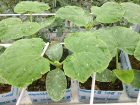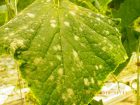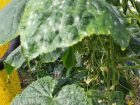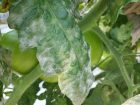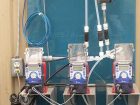
Features
Crop Culture
Inputs
Powdery Mildew of Cucumbers and Tomatoes
Focus on good environmental control to avoid very high and very low relative humidities.
November 13, 2015 By Dr. Mohyuddin Mirza
December 2015 — I have decided to write about the powdery mildews (PM) this month because I found very serious infections earlier this year both on tomatoes and cucumbers. As the name suggests, most growers recognize the symptoms easily by observing white, powdery stuff on the upper surface of leaves. The pictures accompanying this article adequately describe the symptoms.
Picture A shows seedless cucumber seedlings with early infection of PM. Most of the time, such infections happen when seedlings are grown when the old crop is still around with PM. When the old crop is removed by cutting the plants and dragging them, a large number of spores get dislodged and land on the leaves of young seedlings. In the picture one can see even the cotyledonary leaves are infected. If infections of PM start that early, then there is trouble for the crop and growers will resort to applying fungicides at such a young stage. I have seen leaf toxicity of various types with such an early application.
Picture B is of the same crop where, in spite of an application of various fungicides, the mature crop was still showing the PM infections. It became a challenge to control this fungus. Ultimately, the crop was so badly damaged that production was affected. I will discuss the role of proper environmental control to manage this disease.
Picture C is of a 14-week-old crop in which almost 50 per cent of the leaf area was infected. Leaf puckering can also be seen. In this particular case there was evidence of Cucumber Green Mottled Mosaic Virus as well.
Picture D is of PM on tomato crops. This year it was particularly severe in Alberta, likely due to high humidity followed by dry, sunny periods. I remember powdery mildew was first found and reported in Alberta in early 1990s. Since then I see it more frequently.
PM-tolerant or resistant varieties are available with both tomatoes and cucumbers and are worth testing under your greenhouse conditions. Please check with suppliers and crop specialists for their suggestions.
So what should we know about this fungus? The powdery mildew group of fungi includes many different genera and species.
For greenhouse crops, five genera are considered important. They include Erysiphe, Leveilulla, Podosphera, Oidium and Golovinomyces. The important fact I learned during my studies was that powdery mildew are “obligate” pathogens, meaning that they need living plant material on which to grow and propagate. Some are host specific, which means that PM from one plant species would not infect other plants of a different species in the greenhouse, while other PM fungi can infect many hosts. This means that grower should know what PM fungus they are dealing with.
KEEPING PM UNDER CONTROL
Here are some practical things you should know to manage or control this disease:
The PM fungi produce very large number of white spores, technically called “conidia,” which, when dislodged, land on new leaves and start new infections.
The fungi produce more conidia under low relative humidity conditions. You may have noticed that the first symptoms of infection appear where there are high ventilation areas, such as near the exhaust fans.
Low relative humidity can be anywhere below 50 per cent.
Once the conidia land on a leaf surface, they need free water (condensation) to start germination process.
In this aspect, the PM fungi resemble botrytis (grey mould). How does this condensation occur? Let us understand as to what is going on inside the greenhouse during daytime and nighttime conditions.
During the day, the plant is evaporating large amounts of water into the air and we are ventilating to bring the relative humidity down below 80-85 per cent. Depending on outdoor conditions, you open vents or use fans to get rid of warm and humid air, bringing fresh and drier air into the greenhouse.
At night, the temperature is a few degrees cooler than the daytime, but plants are producing water by the chemical reaction of what is called respiration. If you have computers, you can see the relative humidity is around 95-98 per cent, or even higher. This means the air around the leaves is saturated with water. So when you are raising the temperature early in the morning, there is a possibility of dew being formed on the leaves.
Thus by paying attention to relative humidity inside the greenhouse, one can reduce or practically eliminate the chance of PM fungi to germinate and start new infections.
Many fungicides are registered and are available for PM control.
Many organic growers just wash the spores off with water that contains an organic surfactant. The spores dislodge and end up on the plastic surface or soil and cannot germinate, but remember that the spores can stay on soil and debris for a long time.
I conducted research several years ago on the use of potassium silicate to promote the health of cucumbers and tomatoes. It was found that cucumbers take up silicon very effectively, and if used as part of a fertilizer program, it can help with controlling or reducing the incidence of PM diseases.
Its application requires some fine-tuning. There is abundant evidence in research literature about the effectiveness of potassium silicate to improve the health of plants and reduce the incidence of PM.
Picture E is from a commercial greenhouse at which potassium silicate is added to the nutrient solution. Also it is worth noting that if its use is stopped, then within two to three days, the PM fungi can appear on the new growth.
To summarize, growers should focus on good environmental control strategies to avoid very high and very low relative humidities. Check for condensation early in the morning on the leaves. Use fungicides wisely. Avoid growing young seedlings when an old and infected crop is nearby – just hanging a plastic sheet to separate the old and young plants is not enough.
Dr. Mohyuddin Mirza is an industry consultant. He can be contacted at drmirzaconsultants@gmail.com.
Print this page
